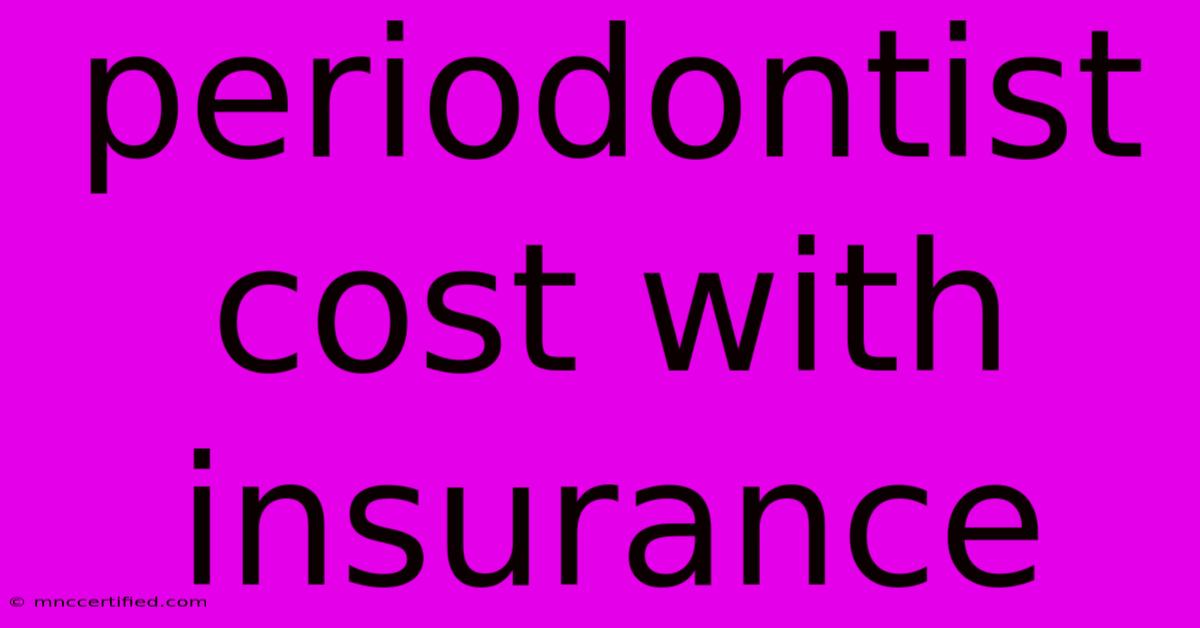Periodontist Cost With Insurance

Table of Contents
Periodontist Cost with Insurance: A Comprehensive Guide
Navigating the world of dental insurance can be tricky, especially when dealing with specialized procedures like those offered by a periodontist. Understanding the costs associated with periodontal treatment and how your insurance impacts those costs is crucial for budgeting and planning. This comprehensive guide will break down the typical expenses, insurance coverage variations, and strategies to minimize your out-of-pocket expenses.
Understanding Periodontist Costs: A Wide Range
The cost of seeing a periodontist varies significantly depending on several factors:
- Geographic Location: Costs in major metropolitan areas tend to be higher than in smaller towns or rural areas.
- Specific Procedure: A simple cleaning will cost less than a complex gum graft or bone regeneration surgery. Procedures like scaling and root planing, periodontal surgery (flap surgery, guided tissue regeneration), and placement of dental implants all have different price points.
- Periodontist's Experience and Expertise: More experienced and specialized periodontists may charge higher fees.
Rough Estimates (These are averages and can vary widely):
- Initial Consultation: $50 - $150
- Scaling and Root Planing (Deep Cleaning): $500 - $1500 per quadrant (your mouth is divided into four quadrants)
- Gum Graft: $500 - $2000 per graft
- Bone Regeneration: $1000 - $4000+ per site
- Dental Implants (Periodontist often involved): $3000 - $6000+ per implant (excluding crown)
How Dental Insurance Impacts Periodontist Costs
Dental insurance plans vary considerably in their coverage for periodontal procedures. Here's what you need to know:
- Annual Maximums: Most plans have a yearly limit on how much they'll pay. Expensive periodontal treatments can quickly eat into this limit.
- Waiting Periods: New policies often have waiting periods before major services like periodontal treatment are covered.
- Coverage Percentages: Insurance companies typically cover a percentage of the procedure's cost, leaving you responsible for the remaining co-pay or coinsurance. This percentage varies widely depending on your plan. For instance, one plan might cover 80% of the cost of scaling and root planing, while another might only cover 50%.
- Preventive vs. Restorative Care: Preventive care (like regular cleanings) is generally covered at a higher percentage than restorative or surgical periodontal procedures.
- Pre-authorization: Some plans require pre-authorization for specific procedures before they'll cover them. Always check your policy details.
Decoding Your Dental Insurance Policy
Before your appointment, carefully review your policy's details:
- Identify covered periodontal procedures: Check the list of covered services.
- Determine coverage percentages: Understand your co-pay, coinsurance, and deductible.
- Look for limitations and exclusions: Some plans exclude certain periodontal treatments or have limitations on the frequency of coverage.
- Check for pre-authorization requirements: Find out if you need prior approval for any procedures.
Minimizing Your Out-of-Pocket Expenses
Several strategies can help minimize your costs:
- Choose an In-Network Periodontist: Using a periodontist in your insurance network will generally result in lower out-of-pocket costs.
- Payment Plans: Many periodontists offer flexible payment plans to make treatment more affordable.
- Dental Savings Plans: Consider joining a dental savings plan that provides discounts on periodontal procedures.
- Negotiate Payment Options: Discuss payment options with your periodontist's office. They may be willing to work with you on a payment arrangement.
- Shop Around: Get quotes from multiple periodontists to compare prices and insurance coverage.
Conclusion: Proactive Planning is Key
The cost of periodontal treatment can be substantial, but understanding your insurance coverage and employing smart financial planning strategies can significantly lessen the burden. Proactive planning, including researching your policy and comparing options, can save you money and ensure you receive the necessary periodontal care without unnecessary financial strain. Remember to always contact your insurance provider and your periodontist's office to clarify coverage details before proceeding with treatment.

Thank you for visiting our website wich cover about Periodontist Cost With Insurance. We hope the information provided has been useful to you. Feel free to contact us if you have any questions or need further assistance. See you next time and dont miss to bookmark.
Featured Posts
-
Morrissey Anoints Faithful Newark Review
Nov 21, 2024
-
Is Oxervate Covered By Insurance
Nov 21, 2024
-
Susan Smith Remains Jailed For Sons Murder
Nov 21, 2024
-
Murray On Merry Gentlemen And Oth Revival
Nov 21, 2024
-
Clayton County Bonding Companies
Nov 21, 2024